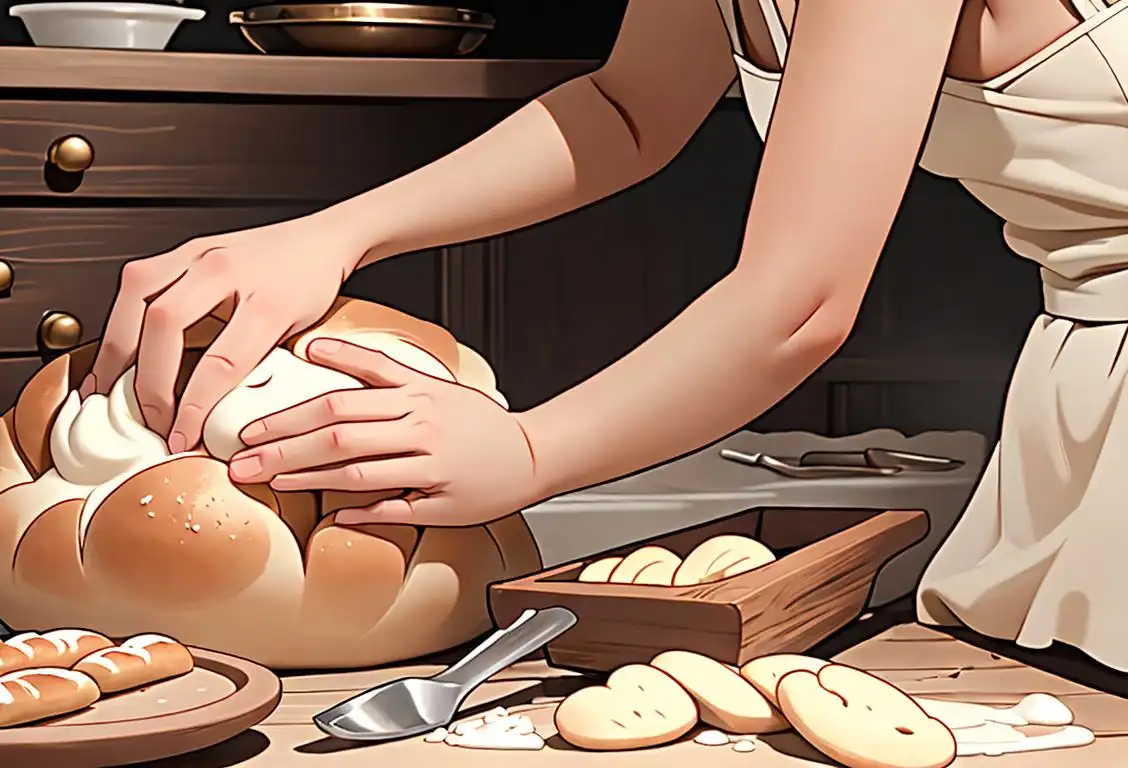National Homemade Bread Day

Are you ready to knead and rise to the occasion? It's time to celebrate National Homemade Bread Day!
When is Homemade Bread Day?
It's national homemade bread day on the 17th November.
Bread and Butter of the Internet
Have you ever wondered how the internet became so obsessed with celebrating food? Well, it all started with National Homemade Bread Day, a day dedicated to the art of baking delicious bread in the comfort of your own home.
This national day gained quite a bit of online attention, with a whopping 711 mentions detected across various platforms. The bread enthusiasts were clearly excited and ready to share their love for this homemade delight.
According to our data, the peak of homemade bread mania was observed on November 17th, 2020. Bread lovers united that day to celebrate and share their mouthwatering creations.
The Floury Origins
Homemade bread has been a staple in cultures around the world for centuries. The act of mixing flour, water, yeast, and salt to create something warm and comforting is a tradition passed down through generations.
So, who decided to dedicate a whole day to homemade bread? While we couldn't find a specific origin for this national day, we can imagine it was dreamed up by someone with a passion for baking, seeking to spread the joy and aroma of fresh-baked bread.
Whether you knead the dough by hand, use a trusty bread machine, or experiment with sourdough starters, there are endless possibilities when it comes to homemade bread. From fluffy white loaves to hearty whole grains, the world of bread-making is as diverse as the people who devour it.
On National Homemade Bread Day, people take to social media to share their favorite recipes, tips, and mouthwatering photos of their creations. It's a day to bond over the simple pleasure of bread, celebrating our collective love for this humble food.
Time for Some Tasty Tagging
To fully capture the essence of National Homemade Bread Day, here are some relevant tags to add to your celebratory posts:
- Food
- Loved Ones
- Romance
- Awareness
- Fun
Did You Know?
Did you know that the world's largest loaf of bread ever made weighed an astonishing 1,818 pounds? That's the equivalent of over 32,000 slices of bread! Talk about a carb overload.
History behind the term 'Homemade Bread'
8000 BC
The beginnings of breadmaking
Human history shows evidence of bread as far back as 8000 BC, during the Neolithic era. At this time, people began to transition from a hunter-gatherer lifestyle to settled agricultural communities. They discovered that by grinding grains and mixing them with water, they could create a paste-like substance. This mixture was then cooked over open fires or heated stones to create an early form of bread.
Prehistoric Times
The Origins
Bread has been a staple food for thousands of years, dating back to prehistoric times. Our ancestors discovered that by grinding grains and mixing them with water, they could create a paste. This paste was then cooked over an open fire, resulting in a simple form of bread.
Ancient Egypt (3000 BCE)
The Rise of Professional Bakers
In ancient Egypt, baking became a specialized skill. Professional bakers were responsible for producing large quantities of bread for the population. They developed techniques to perfect the process, including kneading the dough and using natural yeast for leavening.
3000 BC
The rise of leavened bread
Around 3000 BC, the concept of leavened bread emerged. Egyptians discovered that by adding fermented dough or natural yeasts to their bread recipes, the dough would rise and result in a lighter and more flavorful bread. This marked a significant advancement in breadmaking techniques and led to the creation of various types of bread with different textures and flavors.
Roman Empire (200 BCE)
Improvements in Baking
During the Roman Empire, bread baking reached new heights. They developed advanced milling techniques, which resulted in finer and whiter flour. The Romans also introduced mechanical kneading machines and ovens with separate compartments for baking different types of bread.
100 BC
Roman influence on breadmaking
During the Roman Empire, bread became an essential staple food. Romans introduced advancements such as stone mills for milling grains, which improved the consistency and quality of flour. They also developed sophisticated ovens, allowing for more efficient baking techniques. Bread became a symbol of social status, with different types of bread associated with different classes of society.
Middle Ages (5th-15th Century)
Monasteries and Guilds
In the Middle Ages, monasteries played a central role in bread production. Monks perfected recipes and techniques, and many monasteries had their own mills and bakeries. As cities grew, the craft of baking became organized into guilds, where bakers shared knowledge and ensured quality standards.
1700s AD
Industrial revolution impacts bread production
The Industrial Revolution of the 18th century transformed bread production. With advancements in technology, such as mechanized milling and the invention of the steam-powered oven, bread could be produced on a larger scale. This led to the rise of commercial bakeries and the availability of standardized bread. However, many traditional homemade bread recipes and techniques started to disappear.
Industrial Revolution (18th Century)
Mass Production of Bread
With the advent of the Industrial Revolution, bread production underwent a significant change. Steam-powered mills and mechanized baking processes allowed for large-scale production of bread. The introduction of commercial yeast facilitated the production of consistent and fluffy loaves.
2000s
The revival of homemade bread
In recent years, there has been a resurgence in homemade breadmaking. People have embraced the process as a way to connect with traditional culinary practices, find joy in the art of baking, and have control over the ingredients they use. The popularity of homemade bread has also been fueled by the growth of social media platforms, where bread enthusiasts share recipes, tips, and beautiful bread photos, inspiring others to try their hand at homemade bread.
20th Century
The Homemade Bread Revival
In the 20th century, there was a resurgence in the popularity of homemade bread. People started realizing the satisfaction and taste of freshly baked bread made in their own homes. With the availability of modern kitchen appliances and easy-to-use bread-making machines, homemade bread became a cherished tradition for many families.
Did you know?
Did you know that the world's largest loaf of bread ever made weighed an astonishing 1,818 pounds? That's the equivalent of over 32,000 slices of bread! Talk about a carb overload.Tagged
romance awareness food fun loved onesFirst identified
15th November 2015Most mentioned on
17th November 2020Total mentions
711Other days
Family Day
Action Day
Awareness Day
One Day
Opposite Day
Vodka Boyfriend Day
Kissing Fried Chicken Day
Happiness Day
Suicide Prevention Month Day
Believe Day









